story and photos by Kayte Deioma
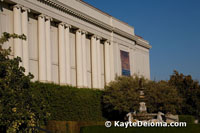 At the edge of the affluent community of San Marino, bordering on Pasadena sits the grand estate of Henry E. Huntington, a railroad and utilities magnate who bought the property in 1903 and used it as a base for developing the San Gabriel Valley. Huntington and his second wife, Arabella, filled the mansion they built on the grounds in 1911 with a world-class collection of British and French art.
At the edge of the affluent community of San Marino, bordering on Pasadena sits the grand estate of Henry E. Huntington, a railroad and utilities magnate who bought the property in 1903 and used it as a base for developing the San Gabriel Valley. Huntington and his second wife, Arabella, filled the mansion they built on the grounds in 1911 with a world-class collection of British and French art.
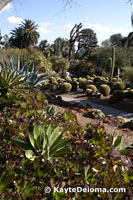 There wasn’t enough room in the house to bring Huntington’s extensive book collection from New York, so he built a separate library building to house the thousands of first editions, historic documents and volumes on the American West. It took multiple railroad cars to bring the collected works to California when the building was finished in 1921. Meanwhile, out on the ranch, a landscape gardener by the name of William Hertrich was busy turning farmland into a showcase of diverse botanical specimens from the local deserts and around the world. Following Huntington’s instructions, the non-profit trust that he formed opened the Huntington Library, Art Collections and Botanical Gardens to the public in 1928, a year after his death.
There wasn’t enough room in the house to bring Huntington’s extensive book collection from New York, so he built a separate library building to house the thousands of first editions, historic documents and volumes on the American West. It took multiple railroad cars to bring the collected works to California when the building was finished in 1921. Meanwhile, out on the ranch, a landscape gardener by the name of William Hertrich was busy turning farmland into a showcase of diverse botanical specimens from the local deserts and around the world. Following Huntington’s instructions, the non-profit trust that he formed opened the Huntington Library, Art Collections and Botanical Gardens to the public in 1928, a year after his death.
Many who visit the Huntington spend all of their time in the Gardens, which is easy to do on a lovely Southern California day. However, if you’re visiting during the winter rains or want to escape the summer heat, there is plenty to do indoors to keep the whole family occupied.
The Huntington Library
The Huntington Library is not your ordinary lending library. The collection contains over 5 million books, manuscripts, photographs and other works related to American and British history, literature and art. Most of these are hidden away in the Munger Research Center, available only to visiting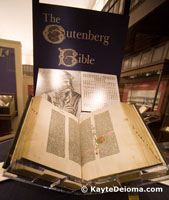 scholars and researchers by special arrangement. For the rest of us, the Library Galleries display some of the most famous pieces along with rotating exhibits.
scholars and researchers by special arrangement. For the rest of us, the Library Galleries display some of the most famous pieces along with rotating exhibits.
One of the best known volumes on display is an original illuminated Gutenberg Bible from around 1455. This is one of the earliest works printed with movable type. Johann Gutenberg is thought to have printed about 180 copies of the Latin bible in his workshop in Mainz, Germany, 45 on vellum and 135 on paper. The Huntington has one of only 12 surviving copies printed on vellum. Only one of the two volume set is on display.
Another highlight of the exhibit is the 15th century Ellsmere manuscript of Chaucer’s The Canterbury Tales, which Huntington purchased from the 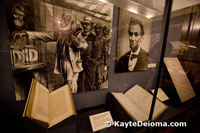 4th Earl of Ellsmere. A double-elephant folio edition of Audubon’s Bird’s of America and early editions of Shakespeare’s works are other rare finds. In the 19th Century British and American Literature section, there are personal letters from Charlotte Bronte, Henry David Thoreau, Walt Whitman and Harriet Beecher Stowe. American history documents include papers related to Abraham Lincoln and the 13th Amendment to the Constitution. The History of the American West is laid out in personal letters, articles, books and photos.
4th Earl of Ellsmere. A double-elephant folio edition of Audubon’s Bird’s of America and early editions of Shakespeare’s works are other rare finds. In the 19th Century British and American Literature section, there are personal letters from Charlotte Bronte, Henry David Thoreau, Walt Whitman and Harriet Beecher Stowe. American history documents include papers related to Abraham Lincoln and the 13th Amendment to the Constitution. The History of the American West is laid out in personal letters, articles, books and photos.
The Art Collections
In the West Wing of the Library, one of the most renowned pieces in the Huntington’s collection, Rogier van der Weyden’s 15th century Madonna and Child, is displayed among Renaissance paintings and French decorative arts and furnishings.
The Huntington Gallery is historically housed in the Huntington’s 1911 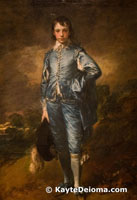 Georgian mansion. However, the mansion is undergoing renovations until summer of 2008, so the French and British art normally on view in the rooms of the main house are temporarily on display in the Erburu Gallery. This includes an impressive group of elegant full-length Grand Manner portraits by Gainsborough, Romney, Reynolds and Lawrence. Two favorites, Gainsborough’s Blue Boy and Lawrence’s Pinkie, which traditionally hung side by side in the mansion, occupy different rooms in the Erburu Galley.
Georgian mansion. However, the mansion is undergoing renovations until summer of 2008, so the French and British art normally on view in the rooms of the main house are temporarily on display in the Erburu Gallery. This includes an impressive group of elegant full-length Grand Manner portraits by Gainsborough, Romney, Reynolds and Lawrence. Two favorites, Gainsborough’s Blue Boy and Lawrence’s Pinkie, which traditionally hung side by side in the mansion, occupy different rooms in the Erburu Galley.
The Lois and Robert F. Erburu Gallery is a wing that was added to the Virginia Steel Scott Gallery in 2005, so you don’t have to go outside to continue to the Scott Gallery. Here you will find paintings by American artists such as Mary Cassatt, John Singer Sargent, and Edward Hopper and sculptures by Frederick Remington.
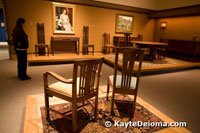 There are several rooms in the Scott Gallery dedicated to the Arts and Crafts Movement in architecture and furnishings. Highlights include three Frank Lloyd Wright chairs and a room devoted to the furniture, textiles and other designs of William Morris and his followers. The largest gallery showcases the work of local architects Henry and Charles Greene who built the Gamble House and many other notable Pasadena properties. There are two fully furnished dining areas with tables, chairs, sideboards, cupboards and leaded glass lamps.
There are several rooms in the Scott Gallery dedicated to the Arts and Crafts Movement in architecture and furnishings. Highlights include three Frank Lloyd Wright chairs and a room devoted to the furniture, textiles and other designs of William Morris and his followers. The largest gallery showcases the work of local architects Henry and Charles Greene who built the Gamble House and many other notable Pasadena properties. There are two fully furnished dining areas with tables, chairs, sideboards, cupboards and leaded glass lamps.
The Boone Gallery, located in the remodeled multi-car garage, hosts temporary exhibits.
The Botanical Gardens
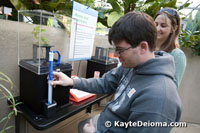 You can don your rain gear and explore the 120 acres divided into 12 themed gardens or you can escape into the Rose Hills Foundation Conservatory for Botanical Science which opened in 2005. Designed to appeal to middle school students, the glass-enclosed science lab allows kids and adults to zoom in on plants and bugs with magnifying video cameras that show the image on large LCD screens. You can test the sugar content of different plant nectars, see how helicopter and parachute seeds are carried by the wind, discover up close why burrs get caught in your
You can don your rain gear and explore the 120 acres divided into 12 themed gardens or you can escape into the Rose Hills Foundation Conservatory for Botanical Science which opened in 2005. Designed to appeal to middle school students, the glass-enclosed science lab allows kids and adults to zoom in on plants and bugs with magnifying video cameras that show the image on large LCD screens. You can test the sugar content of different plant nectars, see how helicopter and parachute seeds are carried by the wind, discover up close why burrs get caught in your 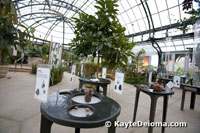 socks, measure the nutrient levels in plant water and generally touch and smell different kinds of plants. If you’ve been through the Art Galleries, you can look for the plants that were in some of the paintings. The popular carnivorous bug-eating plant lab occupies one whole end of the Conservatory. Behind the glass-domed building is the Teaching Greenhouse with more hands-on discovery activities for kids and families.
socks, measure the nutrient levels in plant water and generally touch and smell different kinds of plants. If you’ve been through the Art Galleries, you can look for the plants that were in some of the paintings. The popular carnivorous bug-eating plant lab occupies one whole end of the Conservatory. Behind the glass-domed building is the Teaching Greenhouse with more hands-on discovery activities for kids and families.
The Rose Garden Tea Room and Café
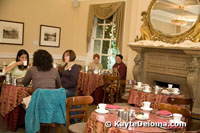 English Tea is served Tuesday through Sunday in the Rose Garden Tea Room. Your English tea consists of a pot of tea, a basket of mini scones and a buffet of bite-size tea sandwiches and mini pastries. The Rose Garden Café on the back of the Tea Room serves deli sandwiches, grill items, snacks and beverages. During the summer you need an advance reservation for the Tea Room, but on a weekday in winter, you can probably walk in or get a reservation on site. No reservations are needed at the Café.
English Tea is served Tuesday through Sunday in the Rose Garden Tea Room. Your English tea consists of a pot of tea, a basket of mini scones and a buffet of bite-size tea sandwiches and mini pastries. The Rose Garden Café on the back of the Tea Room serves deli sandwiches, grill items, snacks and beverages. During the summer you need an advance reservation for the Tea Room, but on a weekday in winter, you can probably walk in or get a reservation on site. No reservations are needed at the Café.
Gift Shop
The Huntington has a first class gift shop and book store where you could probably spend another hour browsing through the books on art and history related to the Huntington collections and other typical museum gift shop items. The store stays open an additional half hour after the Library, Galleries and Gardens close, so you have a chance to stop on your way out.
The Huntington Library, Art Collections and Botanical Gardens
1151 Oxford Road (main entrance at Orlando Road at Allen Avenue)
San Marino, CA 91108
Phone: (626) 405-2100
www.huntington.org

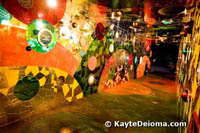 But the signs are easy to spot and they led me into the vast Parking Lot 1, then past the camouflage of uniform-clad soccer teams and bushy trees and up to a big white house with a little round sign near the ground next to the entrance. The contrast between the businesslike exterior and the fantasy that begins as you enter the Kidspace Museum is startling.
But the signs are easy to spot and they led me into the vast Parking Lot 1, then past the camouflage of uniform-clad soccer teams and bushy trees and up to a big white house with a little round sign near the ground next to the entrance. The contrast between the businesslike exterior and the fantasy that begins as you enter the Kidspace Museum is startling.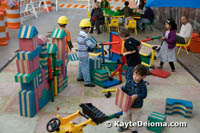 building to the ticket booth that juts into the inner courtyard. Beyond the ticket booth, are two distinct worlds. Mothers at courtyard tables sip their mochas from the Nestle Café by Wolfgang Puck. Just feet away, kids in hard hats work together to create structures of giant blocks or PVC pipe and plastic squares as others drive pint size construction vehicles in the Blasting Zone. Steam shoots up from the pavement, reminiscent of the streets of New York, not Pasadena.
building to the ticket booth that juts into the inner courtyard. Beyond the ticket booth, are two distinct worlds. Mothers at courtyard tables sip their mochas from the Nestle Café by Wolfgang Puck. Just feet away, kids in hard hats work together to create structures of giant blocks or PVC pipe and plastic squares as others drive pint size construction vehicles in the Blasting Zone. Steam shoots up from the pavement, reminiscent of the streets of New York, not Pasadena.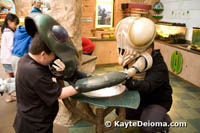 Kids can interact and get a bug’s eye view with people-sized bugs and become servers or customers inBugsy’s Diner or get up close and personal with a real bee hive. They can go on an archaeological dig and discover fossils and dinosaur bones, create an earthquake by moving tectonic plates, drive a jeep or climb up and up and up on all kinds of climbing towers. Supervised art and activity stations let them get as messy and creative as they want.
Kids can interact and get a bug’s eye view with people-sized bugs and become servers or customers inBugsy’s Diner or get up close and personal with a real bee hive. They can go on an archaeological dig and discover fossils and dinosaur bones, create an earthquake by moving tectonic plates, drive a jeep or climb up and up and up on all kinds of climbing towers. Supervised art and activity stations let them get as messy and creative as they want.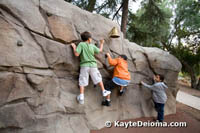 Through the glass doors the Nature Exchange provides hands on opportunities to learn about rocks and fossils. Kids can bring their favorite stones and trade them for different ones.
Through the glass doors the Nature Exchange provides hands on opportunities to learn about rocks and fossils. Kids can bring their favorite stones and trade them for different ones.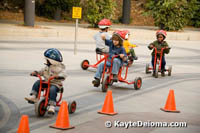 This area really sets Kidspace apart from most other children’s museums. Immediately behind the Digging Deeper building, is the paved Wisteria Courtyard. On one side is Kirby’s Kid’s Korner, where kids can play on a small playground. Most of the rest of the pavement is covered by the Trike Tracks where kids can race around on solo or tandem trikes. In the Stone Hollow Amphitheater on the hillside above the courtyard, staff present educational and interactive shows with costumed characters if the weather is good. The hillside is landscaped as a miniature version of Pasadena’s Arroyo Seco, with a trickle of a stream running down the rocky hill. TheSpider Web Climber, Bat Cave, and the Strata Cliff Climb rock climbing wall are popular highlights of the outdoor exhibit.
This area really sets Kidspace apart from most other children’s museums. Immediately behind the Digging Deeper building, is the paved Wisteria Courtyard. On one side is Kirby’s Kid’s Korner, where kids can play on a small playground. Most of the rest of the pavement is covered by the Trike Tracks where kids can race around on solo or tandem trikes. In the Stone Hollow Amphitheater on the hillside above the courtyard, staff present educational and interactive shows with costumed characters if the weather is good. The hillside is landscaped as a miniature version of Pasadena’s Arroyo Seco, with a trickle of a stream running down the rocky hill. TheSpider Web Climber, Bat Cave, and the Strata Cliff Climb rock climbing wall are popular highlights of the outdoor exhibit.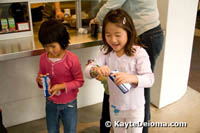 From the central courtyard to the back of the outdoor exhibit, most activities are designed for kids five and up. The Early Childhood Development Center has activities and toys for children four and under in the front building next to the Busy Bee Learning Store. Immediately to the right when you come through the kaleidoscope tunnel is the Nestle Café by Wolfgang Puck. Considering that it is in a museum, the food is reasonably priced, and since it bears the Wolfgang Puck brand, it’s also quite good.
From the central courtyard to the back of the outdoor exhibit, most activities are designed for kids five and up. The Early Childhood Development Center has activities and toys for children four and under in the front building next to the Busy Bee Learning Store. Immediately to the right when you come through the kaleidoscope tunnel is the Nestle Café by Wolfgang Puck. Considering that it is in a museum, the food is reasonably priced, and since it bears the Wolfgang Puck brand, it’s also quite good.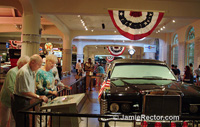 You could be there all day and not see everything. You might expect a museum named for Henry Ford to be all about cars, and there are plenty of exhibits on the development of the automobile. But the majority of space if given over to what began as Henry Ford’s collection of the evidence of American ingenuity in technology and ideas. Ford’s vision included collecting and preserving the objects in people’s daily lives as a way of documenting American history. Throughout the museum and the adjacent Greenfield Village, are mementos from the people Ford cared about as well as things that attracted him. He has Thomas Edison’s last breath contained in a small vial as well as some authentic and replica pieces of his best friend’s life.
You could be there all day and not see everything. You might expect a museum named for Henry Ford to be all about cars, and there are plenty of exhibits on the development of the automobile. But the majority of space if given over to what began as Henry Ford’s collection of the evidence of American ingenuity in technology and ideas. Ford’s vision included collecting and preserving the objects in people’s daily lives as a way of documenting American history. Throughout the museum and the adjacent Greenfield Village, are mementos from the people Ford cared about as well as things that attracted him. He has Thomas Edison’s last breath contained in a small vial as well as some authentic and replica pieces of his best friend’s life.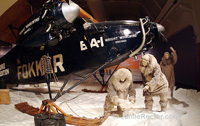 In the Automobile in American Life exhibit, there are antique vehicles, test cars that never made it into the market, race cars and automobiles developed through the 20th century. There are also icons of American life that developed because of the more mobile lifestyle brought on by ease of transportation such as roadside diners and fast food restaurants. Other exhibits showcase the history of other modes of transportation from the stage coach to the locomotive to the airplane.
In the Automobile in American Life exhibit, there are antique vehicles, test cars that never made it into the market, race cars and automobiles developed through the 20th century. There are also icons of American life that developed because of the more mobile lifestyle brought on by ease of transportation such as roadside diners and fast food restaurants. Other exhibits showcase the history of other modes of transportation from the stage coach to the locomotive to the airplane.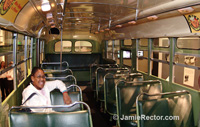 In 2006, the Henry Ford introduced a new exhibit called With Liberty and Justice for All. It includes artifacts from the American Revolution through the civil rights movement. You can only look at Abraham Lincoln’s chair form the Ford Theatre where he was shot and George Washington’s camp bed, but you can climb on the restored Montgomery City Lines bus and sit in the seat where Rosa Parks sat and changed the world.
In 2006, the Henry Ford introduced a new exhibit called With Liberty and Justice for All. It includes artifacts from the American Revolution through the civil rights movement. You can only look at Abraham Lincoln’s chair form the Ford Theatre where he was shot and George Washington’s camp bed, but you can climb on the restored Montgomery City Lines bus and sit in the seat where Rosa Parks sat and changed the world.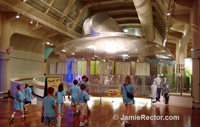 The Henry Ford has also restored the only remaining example of Buckminster Fuller’s Dymaxion House, a round, aluminum dwelling that was designed in 1946 to be inexpensive, easy to assemble and sturdy enough to withstand tornados. Your Place in Time has common everyday items identified by the generation that grew up with them, from the Progressives and War Generation through the Baby Boomers to the Gen Xers and the Next Generation. Other exhibit subjects include agricultural technology, silver and pewter, clocks, home arts and furnishings.
The Henry Ford has also restored the only remaining example of Buckminster Fuller’s Dymaxion House, a round, aluminum dwelling that was designed in 1946 to be inexpensive, easy to assemble and sturdy enough to withstand tornados. Your Place in Time has common everyday items identified by the generation that grew up with them, from the Progressives and War Generation through the Baby Boomers to the Gen Xers and the Next Generation. Other exhibit subjects include agricultural technology, silver and pewter, clocks, home arts and furnishings.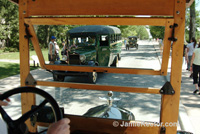 Outside the main museum, Greenfield Village covers 90 acres of the Ford Estate. It is the oldest and largest living history museum in the country. Much of it is outdoors, so an umbrella might come in handy, but there are tours in vintage Ford vehicles that will drive you through the village pointing out various buildings, including the 1929 Martha May Chapel, an English Cottage, a windmill and a clock shop built as a school. Of the 63 structures, 42 were brought here and 21 are replicas. Many of them have interior exhibits with staffed by costumed reenactors.
Outside the main museum, Greenfield Village covers 90 acres of the Ford Estate. It is the oldest and largest living history museum in the country. Much of it is outdoors, so an umbrella might come in handy, but there are tours in vintage Ford vehicles that will drive you through the village pointing out various buildings, including the 1929 Martha May Chapel, an English Cottage, a windmill and a clock shop built as a school. Of the 63 structures, 42 were brought here and 21 are replicas. Many of them have interior exhibits with staffed by costumed reenactors.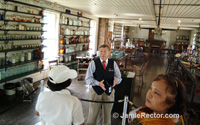 Structures related directly to Henry Ford include his actual boyhood home and replicas of his Bagley Avenue Workshop where he built his first “quadricycle” and a one quarter size replica of his first factory. Ford’s tribute to his friend Thomas Edison include Edison’s Fort Meyers Florida laboratory and replicas of his laboratory, glass shed, machine shop, office and library in Menlo Park New Jersey. The Village includes a Main Street with traditional trades and crafts and historic eating establishments and side streets with the homes, porches and parlors of historic individuals. There are also a number of working farms, mills and a railroad junction with train rides.
Structures related directly to Henry Ford include his actual boyhood home and replicas of his Bagley Avenue Workshop where he built his first “quadricycle” and a one quarter size replica of his first factory. Ford’s tribute to his friend Thomas Edison include Edison’s Fort Meyers Florida laboratory and replicas of his laboratory, glass shed, machine shop, office and library in Menlo Park New Jersey. The Village includes a Main Street with traditional trades and crafts and historic eating establishments and side streets with the homes, porches and parlors of historic individuals. There are also a number of working farms, mills and a railroad junction with train rides.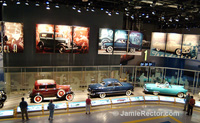 Another part of the Ford extravaganza is The Rouge Tour. A tour bus picks you up and drops you off right in front of the Ford Museum. It is an off site tour of the cars being made in Ford’s Rouge Factory, named for the Rouge River running beside it. There is a multi media introduction that gives a multi-sensory idea of some of the history with seven gigantic screens and chairs that swivel 360 degrees and shake below you. Hot air blows on you; strobes flash. It’s a dramatic display – almost too much.
Another part of the Ford extravaganza is The Rouge Tour. A tour bus picks you up and drops you off right in front of the Ford Museum. It is an off site tour of the cars being made in Ford’s Rouge Factory, named for the Rouge River running beside it. There is a multi media introduction that gives a multi-sensory idea of some of the history with seven gigantic screens and chairs that swivel 360 degrees and shake below you. Hot air blows on you; strobes flash. It’s a dramatic display – almost too much.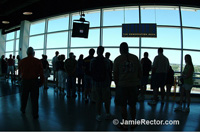 The tour then moves to the observation deck where they show you the world’s largest eco-roof on the top of the Ford building. It is a living, breathing lawn that is used to naturally help keep the building 10 degrees cooler in summer and also warmer in winter. When that part of the tour is over, there’s a self-guided tour around the actual factory. High above the employees, you can walk a circle around the entire top of the plant and watch the cars being pieced together, from frame to windshield wipers.
The tour then moves to the observation deck where they show you the world’s largest eco-roof on the top of the Ford building. It is a living, breathing lawn that is used to naturally help keep the building 10 degrees cooler in summer and also warmer in winter. When that part of the tour is over, there’s a self-guided tour around the actual factory. High above the employees, you can walk a circle around the entire top of the plant and watch the cars being pieced together, from frame to windshield wipers.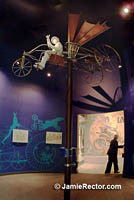 If you haven’t had enough of the auto culture, on the same property as the Ford Museum is the independent Automotive Hall of Fame. This is less a look at how cars are made and more about the people in the world that have had a major impact on the automotive industry in every corner of the world. Every year they add new inductees and celebrate people such as Sakichi Toyoda, founder of Toyota Industries and Soichiro Honda, founder of Hondo Motor Company as well as the dealerships that sold the most vehicles. There are interactive displays where kids or adults can build their own cyber hotrods. It’s not very big, so it won’t take too much time, but it’s a nice supplement to the rest of what Motor City has to offer.
If you haven’t had enough of the auto culture, on the same property as the Ford Museum is the independent Automotive Hall of Fame. This is less a look at how cars are made and more about the people in the world that have had a major impact on the automotive industry in every corner of the world. Every year they add new inductees and celebrate people such as Sakichi Toyoda, founder of Toyota Industries and Soichiro Honda, founder of Hondo Motor Company as well as the dealerships that sold the most vehicles. There are interactive displays where kids or adults can build their own cyber hotrods. It’s not very big, so it won’t take too much time, but it’s a nice supplement to the rest of what Motor City has to offer.